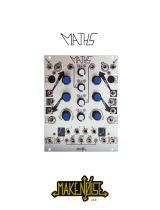
Understanding the MMG cont.
The Q-Factor control
This is where the amount of resonance is programmed in the filter. Almost all music synthesizer filters have a
control for resonance or Q-Factor (aka Q). The MMG offers voltage control over this behavior. The first half
the Q range generates clean resonances, not unlike what is heard from many analog filters. After 50% you
will notice the Q-Clip Indicator lighting (this is the PINK LED) and the sound of the resonance will become
more and more aggressive and harmonically rich. At some settings the resonances will over-take the Input
Signal in amplitude! In fact, the Q-Factor circuit allows the filter circuit to resonate to the point of oscillation in
some cases. This is where the AC IN Drive control becomes handy. The MMG Q-Factor circuit is directly
impacted by the Input Signal levels. By adjusting the AC IN Drive control you will be able to control the
possible strength of the Q-Factor circuit. If you want really strong resonance, try setting the AC IN Drive
lower. If you want the input signal to be stronger, set the AC IN drive higher. Keep in mind that because the
lowest range of the FREQ control performs like a VCA and attenuates the signal, there is a loss of energy at
FREQ settings below 10 o' clock and the resonance will recede quickly at these settings as well.
The STRIKE
This input is only found on one other filter, the Make Noise Optomix (it is also found on the Make Noise
DPO, but that is not a filter).
The Vactrol based gain cells utilized in the MMG have a moderately fast attack time and a slower decay
time, meaning the circuit turns on quickly, but takes a while to shut off, yielding a smooth natural decay to
almost any signal processed. The STRIKE Input is a Gate input for striking or plucking the Vactrol. This
means that when a Gate signal is received at this input, the Vactrol based gain cell is opened up to 100% for
a brief amount of time, and then allowed to close on its own, thus allowing the circuit to impart its magically
slow response time upon the amplitude of the signal being processed.
The STRIKE input is useful for percussively animating a sound, since the fast turn on and slow turn off is
reminiscent of a percussion instrument like a bongo, tom-tom or other drums.
The ACCENT This is another, less common parameter to be found on a filter. The MMG ACCENT circuit
resembles that of a certain Japanese made bass synthesizer that was packaged in a silver box. The
ACCENT circuit in that silver box failed miserably at achieving the intended goal of naturalism in computer
controlled music composition. Still, the ACCENT circuit became widely used in some styles of electronic
music such as ACID and TECHNO. Within these music styles, artists used ACCENT to create hard hitting
notes that punched through the mix.
The OUTPUT Stage
There is one output on the MMG. There is one thing about that single output stage that is not typical though,
and that is the inclusion of an Automatic Gain Control circuit. This AGC circuit is not found on the original
QMMG. The AGC scales the amplitude of the output signal as the resonance is increased. When set to high
resonance levels, the amplitude of the output signal from the MMG (and the QMMG) filter core will almost
double. The AGC circuit following the Filter core will prevent this massive increase in amplitude.
QMMG purists should have no fear though, as it is possible to trim out almost all of the AGC scaling. See the
calibration procedure for how you could set the AGC to your taste.















